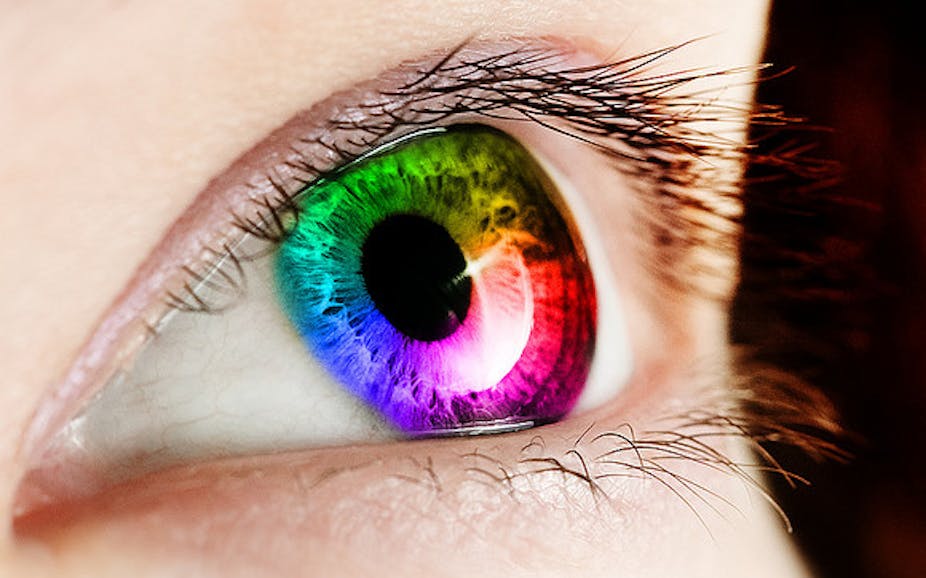For more than 200 years, scientists have known the range of colours we can see means there must be three different types of light-responsive cells in our eyes.
These three types of cell, along with the pathways the information travels in towards the brain, have now been extensively characterised.
But we are still far from understanding how colour is processed in the brain, and how that’s influenced by memory, learning and expectations.
Research and technology
A 2006 study demonstrated one such influence on colour processing by asking people to adjust the colour of a picture of an object until it appeared grey. When the object had a colour such as the yellow of a banana, it needed to be tinged with its opposite colour to appear truly grey.
Colours are encoded as “opposites” of one another by the brain (known as “opponent colour theory”). Because of the way our brains are wired, “less red” is equivalent to “more green” and “less yellow” is equivalent to “more blue”.

Research participants found that when a banana-shaped object was grey, it still appeared slightly yellow due to the effects of memory and prior experience. By making the object slightly blue, the imaginary yellow was “nulled” out.
The experiment shows we can’t distinguish the way memory affects colour perception from colour sensations based on the physical world.
To understand this and other higher-level influences on colour perception, we need to understand the processing of colour that takes place in the brain’s visual cortex, a handful of steps “downstream” from the light-responsive cells in the eye. And technology may provide the answer.
With the use of high resolution functional Magnetic Resonance Imaging (fMRI), scientists have been able to measure activity in the brains of people while they view coloured pictures and films. This resulted in a series of “snapshots” of a complex system at work. This technology has allowed us to develop a better understanding of how the brain responds to colour.

The history of colour processing
For more than 100 years, evidence suggested that specific parts of the brain were responsible for different functions. Early evidence of specialisation within the visual cortex came from the work of a Japanese ophthalmologist Tatsuji Inouye, who, in the early 20th century, carefully measured the vision impairments of soldiers with brain injuries sustained during the Russo-Japanese War.
Further study of people with brain lesions that caused damage or loss of colour vision resulted in particular areas of visual cortex being proposed as “colour processing centres” of the brain.
Neuroimaging has confirmed that some parts of the brain respond more strongly to colour than others. But generally, imaging has revealed that colour processing is more distributed) through the visual cortex than previously thought.
In a recent study, we measured the visual cortex response of subjects watching full colour and black-and-white clips from Baz Luhrmann’s Strictly Ballroom. We found that, in addition to a strong colour response in a hypothesised “colour area”, there was also a strong preference for colour in other areas, from which the “colour area” receives input. This finding adds to evidence against the notion that colour is a feature extracted by and represented in a restricted visual area within the brain.

Surprisingly, neuroimaging has also revealed that many higher-order aspects of vision are present in the response from the earliest lower-level areas that are the first cortical areas to receive input from the eyes.
This suggests that the influence of cognitive and other high-level processes may extend down to these basic levels of sensory processing, through feedback connections. Not only are there lots of areas of the brain that respond strongly to colour, they all seem to “talk” to one another.
Looking at a normally functioning human brain is of particular importance when we want to understand not just what functions different areas of the brain perform, but how different parts of the brain interact.
These insights help us understand how the brain processes information about colour. And further research in this area will hopefully help us understand brain processing more generally. Neuroimaging provides us with the ability to look inside a normally functioning human brain, rather than basing conclusions on specific cases of brain injury.
How well do you see colour? Take the x-rite FM 100 Hue Test

